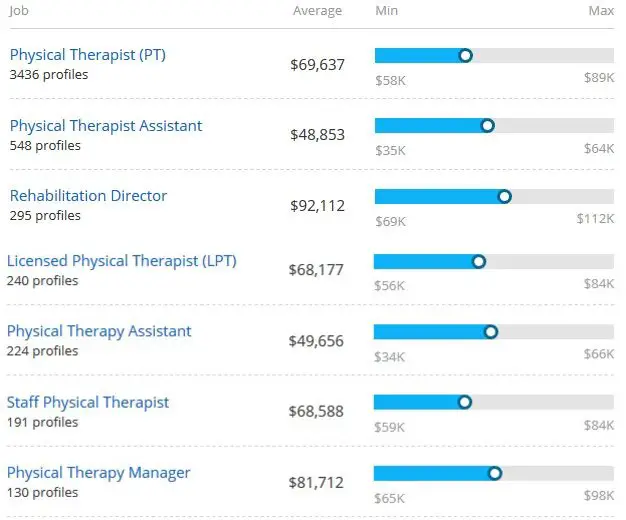How to become a Physical Therapist
This article provides in-depth information into What is a Physical Therapist? What Physical Therapists do? Degrees for Physical Therapists, Steps to become Physical Therapist and much more.
A physical therapist is a professional who is trained to focus on the patient's exercise plans, improve flexibility, stamina, strength, and manage their pain through constant motivation. here is everything you need for becoming a Physical therapist.
What does a Physical Therapist do ?
They provide healthcare for patients of all ages with medical conditions such as an accident, fracture, sprains, illness, injuries, neurology disorder, and other chronic conditions by developing an effective treatment plan.
-
Learn about the patient's condition and medical history
-
Conduct test on the patients to identify the problem
-
Interpret the test results and design the course of treatment
-
Assess The patients with subtitle treatment and modify it accordingly during the recovery phase
-
Effective use of suitable equipment, therapies, and exercises to facilitate health and wellness
-
Direct the technicians and assistants about the treatment plans
-
Educate their patients on what to expect and the changes they face during the treatment process
Steps for becoming a Physical Therapist
1
Earn A Bachelor's Degree
You must earn a Bachelor's degree in any health-related field to gain some prerequisite knowledge before entering the doctoral degree. You could choose your discipline such as Anatomy, Physiology, Biology, Chemistry, Physics.
This program is essential before you enroll in the professional Doctor of Physical Therapy( DPT) program.
2
Complete The Doctor Of Physical Therapy Program
After completing the undergrad degree, you should aim at earning the DPT program which is accredited by the Commission on Accreditation in Physical Therapy Education (CAPTE) for a period of 3 years, where they provide more than 200 fields of specialization.
You must apply for the DPT program through the Physical Therapist Centralized Application Service (PTCAS) and after the coursework gain clinical experience at an internship under a senior therapist.
3
Obtain The License
According to state regulations, PTs must obtain a license to get the job and this includes clearing the National Physical Therapy Examination (NPTE) by the Federation of State Boards of Physical Therapy (FSBPT). The exam is computerized and consists of objective type questions that test the aptitude of the candidate based on practice and theoretical physical therapy. For issuing the license, the criminal background check is done. You are also required to continue the education credits to keep the license active
4
Complete The Residency
This is an optional clinical residency program you can choose after earning the DPT degree. It provides hands-on experience in the specialty areas by completing 1500 hours of clinical experience where you get to complete it within 36 months. Students are benefited by this program by conducting research while they are guided under the direct supervision of a licensed therapist.
5
Get A Certification
After gaining experience in the professional field of physical therapy, you can apply for a certification from the American Board of Physical Therapy Specialties(ABPTS). You require a total experience of 2000 hours of clinical experience to become a certified Physical Therapist. The 8 specialization areas include the,
-
Sports - both amateur and professional athletics
-
Orthopedics
-
Geriatrics
-
Neurology
-
Clinical electrophysiology
-
Cardiovascular & pulmonary
-
Pulmonary
-
Women’s health
Physical Therapist Degree Levels
Associate
In an associate degree program, students gain the knowledge and skills they need to assist physical therapists as they work on patients. Students learn the fundamentals of the profession through both classroom instruction and practical training with a licensed physical therapist. The following are samples of courses offered in a PTA associate degree program.
Physical therapist assistant procedures
-
Development of the Physical Therapy Profession
-
Physical Therapy Clinical Practice
-
Documentation and Patient Issues
Objectives
-
Evaluating the patient's progress
-
Gain knowledge on the necessary equipment for treatment
-
Assist the patient to perform the exercise
-
Learn the patient's psychology and neurological disorders
Clinical kinesiology
-
The Movement System
-
Muscle Activity and Strength
-
Elbow and Forearm Complex
Objectives
-
Test the muscle functioning
-
Measuring the joints
-
Understand the normal body movements off patients
-
Recognize the abnormality in the patient
Therapeutic exercise
-
Sacroiliac Dysfunctions and Muscle Energy
-
Soft Tissue, Neural, and Joint Mobilization
-
Extremity Therapeutic Exercise
Objectives
-
Understand the concept of tissue repair, i.e: Mechanotherapy
-
Design exercise for the medical conditions
-
Clinical decision making
-
Learn safe exercise techniques for all ages
-
Evaluate the performance of the patients
Assistive devices
-
This course educates the students about the various assistive devices developed and how they can be used.
Objectives
-
Learn about the various assistive devices
-
Recommend the right device according to the health issue
-
Instruct the patients on how the devices can be useful
Bachelors
In this four years program, students learn the role and duties of the physical therapists. This lets students to get a comprehensive knowledge on the field with diverse coursework and also acts as a stepping stone to the doctoral degree. This gives the necessary prerequisites to enter into the doctoral degree and become professional.
Health science statistics
-
Populations & Samples
-
Nonparametric statistics
-
Survival analysis
Objectives
-
Analyzing patient data through different statistical methods
-
Understanding of statistical methods such as correlation and inferential statistics
-
Analysis of variance
Athletic injuries
-
Training and Conditioning Techniques
-
Nutritional Considerations
-
Tissue Response to Injury
Objectives
-
Diagnosing athletic trauma
-
Creating and implementing preventive plans for patients at risk of injury
-
Ability to apply sports medicine principles
Pharmacology
-
Introduction to pharmacology
-
Principle of drug administration
-
Interpretation of medication order
Objectives
-
Knowing which drugs are appropriate for different conditions
-
Recognizing drug abuse issues
-
Understanding the physical and psychological effects of different drugs
Health psychology
-
This course is to understand the effects of biological, social, and psychological factors on the body. Also promoting a healthy lifestyle and prevention of illness.
Objectives
-
Recognize the mental health of the patient
-
Effects of pain on the psychological factors of patients
-
Suggesting nutrition to reduce pain and improve the conditions
Doctorate
You can take the Doctor of Physical Therapy program after earning a bachelor's degree in a health-related field. You could also choose this if you have worked as a physical therapy assistant or in any health-related positions.
The DPT program is 80 percent classroom learning and the 20 percent is lab studies which include subjects such as biology, functional anatomy, cellular histology, physiology, exercise physiology, biomechanics, kinesiology, neuroscience, pharmacology, pathology and other.
Health psychology
-
The story of health psychology
-
Health and Media
-
Experiencing, measuring, and coping with stress
Objectives
-
Understanding how pain affects a patient’s psychological state
-
Making nutritional recommendations that alleviate pain and stress
-
Ability to recognize mental health issues
Assistive devices
-
Background Information on Assistive Technology
-
Introduction to Assistive Technology
-
Measurement Instruments
Objectives
-
Choosing the right wheelchair for a patient
-
Understanding how patients use assistive devices such as walkers, crutches, and canes
Neuroscience in Rehabilitation
-
Introduction to the Brain
-
Metabolism, Cerebral blood flow, CSF
-
Cerebellum
Objectives
-
Organization, structure, and function of the human central nervous system
-
Nervous system function and dysfunction
-
Foundation in neuroscience
Online course for physical therapy
You can also choose the online courses available from an online physical therapy school. You must always research about the details of the online program, the course offered and whether it aligns with your career goals. You must choose the courses accredited by the Commission on Accreditation in Physical Therapy Education (CAPTE) to get the right skills and develop the research skills and have a flexible study plan.
Salary for a physical therapist
According to the 202, the salary data for a physical therapist in the United States is about $87,479 per year and typically ranges between $80,585 and $94,913 and this depends on the education, requirements, certification stand out skills and also the work experience gained.
Job growth
According to The Bureau of Labor Statistics, the employment opportunities for a physical therapist is expected to grow about 28 percent during the period of 2016 to 2026, which is considered as a rapid growth compared to the occupations.
This is due to the increased demand for a physical therapist and the present generation to go to them for feting their injuries, and other medical conditions treated. There are currently 239,800 physical therapists working in the United States.
| Minumum Credit Score | Apply in as little as | Variable APR | Fixed APR | ||
|---|---|---|---|---|---|
 | Not Available | 15 minutes or less | 2.95 | 4.74 | View disclosures |
 | 620 | 2 minutes | 5.38%-16.99%1 | 4.43%-16.99%1 | View disclosures |
 | Not Available | 15 minutes | 1.13% - 11.23%¹ (with autopay) | 3.50% - 12.60%¹ (with autopay) | View disclosures |
